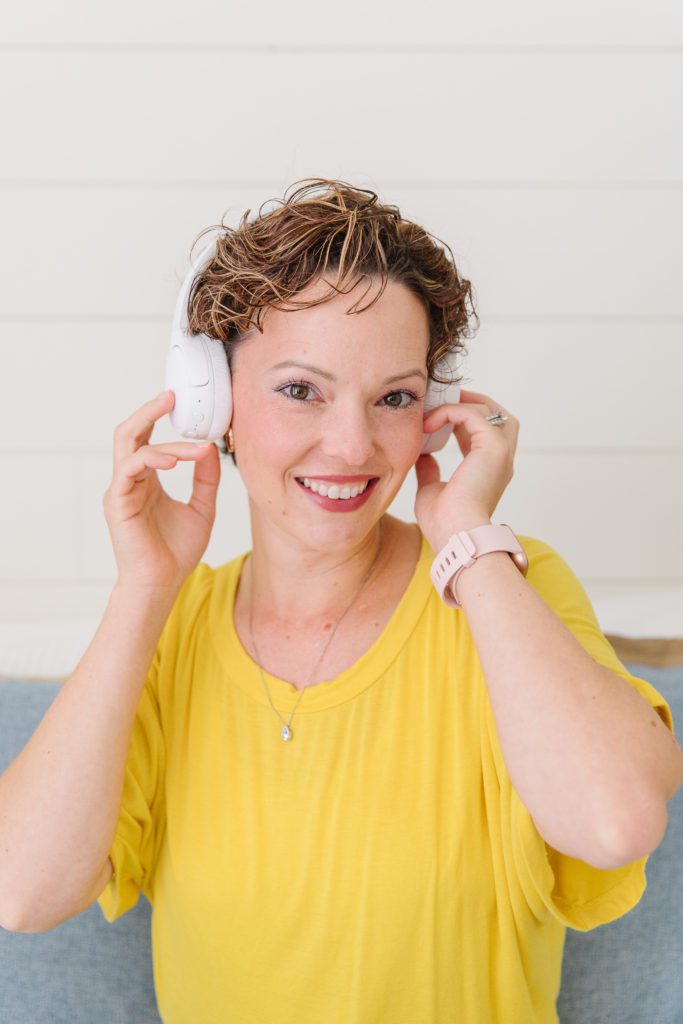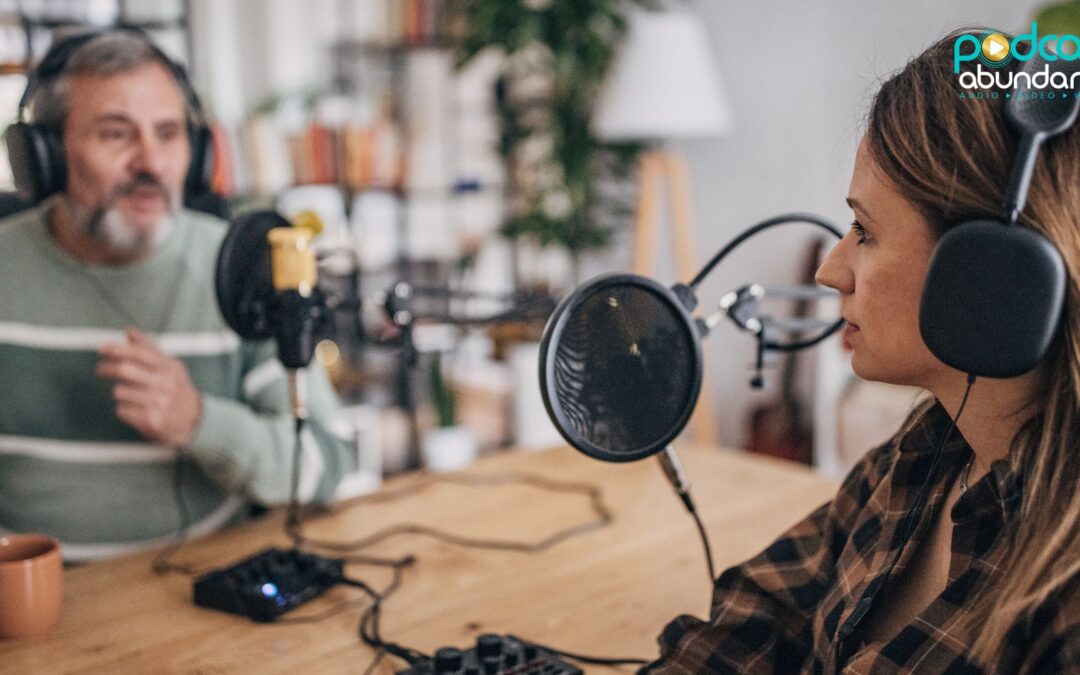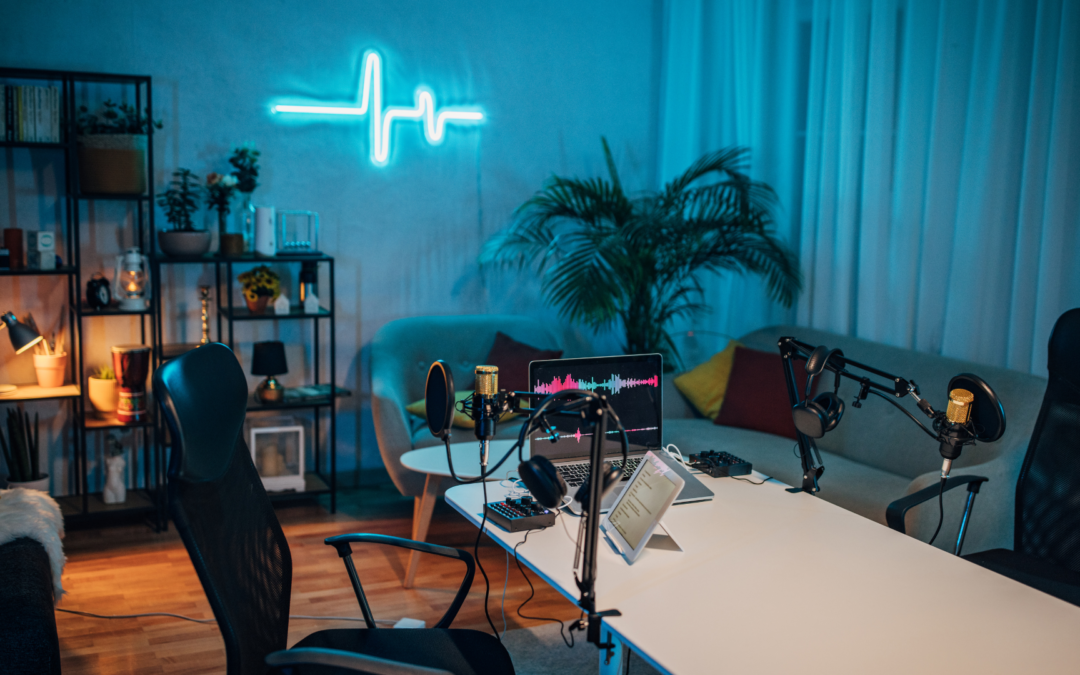How To Reduce Background Noise From Your In-Home Podcast Studio
I don’t care if no one else is home, you put the dogs in their crates, and you’ve silenced all notifications. There is ALWAYS ambient noise around you – go ahead, sit still and listen intently to the sound of your space. Hear that???
Your microphone will likely pick up all of that AND your voice, but to have the clearest, cleanest sound possible, we need to explore some noise reduction options you can do before you hit record that will ensure your sound is as high-quality as possible.

How To Reduce Background Noise From Your In-Home Podcast Studio
You want to create a podcast you’re proud to share with your audience, friends, and family, and that means you need professional-sounding audio. You want your voice heard clearly with little or no other ambient sounds as a distraction to your listeners. Well, you’re in the right place because every studio, home, and office has ambient noises that will be picked up in your audio.
So here you are wondering – How do I prevent background noise, white noise, and other sounds from being picked up as I record my show?
In this article, you’ll find out how to easily reduce background noise, prevent audio interference, and record your voice as clearly as possible so that you’ll be well on your way to producing that powerful podcast you’ve been dreaming of!
Don’t panic if you’re unfamiliar with recording equipment or if tech freaks you out. I’m all about simplicity and you can produce excellent sound quality from your home studio. You just need a little guidance on noise suppression, that’s all!

How To Prepare A Quiet Space For Podcast Recording
When done right, recording your podcast from home can sound equally high in audio quality as one recorded in a fancy studio with all the expensive bells and whistles. The key is finding the best place to record at home and properly preparing the space for recording.
Choosing the right environment matters. That means never record in a bathroom, anywhere with vaulted or cathedral ceilings, near a window, or outdoors, unless, of course, there’s an element of reverb or background noise you’re purposely bringing into the audio track.
Pro Tip: The less background noise you can record upfront, the less work, special software, money and detail it will take to remove background noises during post-production and the clearer your audio will be for your listeners.
Setting Up Your Podcast Recording Space For Noise Reduction
- Find a small, quiet space. A closet works great for a recording studio.
- Take a few minutes to sit in the space and listen to and record about 15 seconds of ambient noise – this is called room tone.
- Sound treat your recording space because every sound produced in your studio will come into contact with a surface and either be absorbed or bounced back. To DIY this task, use rugs and carpet for flooring, and on the walls use acoustic foam, mattress foam, or packing blankets.
In an un-treated space, for example, an empty closet with wood or tile floors, even when you’re speaking directly into your microphone, your recording will pick up background noise simply because your sound waves will bounce off every hard surface surrounding you and create echo, or, what’s referred to in podcast land as reverb.
Reverb is a tough fix for any podcast editor and can only be done with great noise removal software and some expertise. It’s much better to get ahead of the curve by preventing unwanted sound from ever having a chance to ruin your good audio.
In addition to hanging acoustic foam or fabrics on the walls in your space (stylish ideas include curtains, pretty rugs, quilts, fabric in your brand colors stretched over a wooden frame and arranged like tiles on the wall as a nice background, table cloth, etc. Check that linen closet!) make sure you can move around in your chair without it creaking or squeaking. This doesn’t have to be an expensive endeavor and I highly recommend just getting started with your podcast by using “free” fabrics you already own.
Producing a good audio recording does take practice. You may have to adjust your microphone settings, get a bump-resistant mic stand, seek resources for mic technique, close windows and move away from other similar sound sources, etc.
In other words, expect a little trial and error when it comes to ambient noise reduction. You’ll perfect your technique, become hyper-aware of background noises, learn more about your microphone and pop filter than you ever thought possible, and continually work toward achieving the sound that best aligns with your brand personality and podcast type.
Pro Tips for How To Reduce Background Noise on Mic
Remember, what you put into your podcast is what you’ll get out. If your audio is full of background noise, the end result will be unprofessional, full of distracting ambient noises, and likely offer a listening experience that won’t bring listeners back for more. The industry-wide best practice is to do your research and remove background noise sources prior to (and during if needed) recording to eliminate any unwanted noise.
While some edits can be made, don’t rely on post-production for sound repair or complete noise reduction. The tweaks made post-recording are to be used for damage control only. Sure, there’s excellent echo cancellation and noise reduction software out there, but clean audio directly from the sound source is always going to be more pleasing to the ear than audio that had to be repaired.
Also, keep in mind that some background noise is better to listen to than digital artifacts created by over-editing. Take into consideration the vibe and style of each episode when you’re looking to remove background noise.
If you’re attending a conference and are interviewing people on the conference floor or while other speakers conduct their presentation, for example, this takes room tone to an entirely new level. Noisy environments such as this shouldn’t (and probably can’t) be completely removed from the audio recording. In this case, there’s value to keeping the background sounds in the episode as they actually help your audience feel what it might be like to be there live.
Most Common Types of Noise and How to Eliminate Them
#1 – Mechanical Noise
Various motors and machines run our homes. Mechanical noise is comprised of all these sounds we hear on a daily basis that you probably don’t even notice anymore. Think air conditioners, the computer fan, the refrigerator, the clock ticking – these ambient sounds of our homes are produced by mechanical components all around us.
I challenge you to sit so still in your home that you would hear a pin drop. You’ll notice the sound of your breath, your heartbeat, the rustle of your clothes or hair when you move ever so slightly. What else do you hear? You might be shocked at how “loud” your quiet space really is!
The most reliable ways to eliminate these low frequencies are to turn them off if possible or move away from the culprit. Using a dynamic mic also helps to reduce the likelihood that background noise will be picked up in the audio recording.
#2 – Electrical Noise
Electrical noise is typically the high-frequency buzzing you get when something isn’t plugged in all the way, cords are touching, or if some of the equipment you’re using has a bad connection. You’ve inevitable been to a live speech or concert where you’ve experienced the high-pitched buzz when someone steps too close to other sound equipment while holding the mic. That deafening shriek should be avoided at all costs.
The top way to eliminate these sounds is to check all hardware connections and make sure they’re secure and not damaged.
Electrical sounds are very difficult to remove post-production. Try your best to get rid of these sounds prior to recording. If you’ve recorded and hear any dreaded electrical sounds, rerecording is the best solution for quality audio.
#3 – Clicks, Pops & Mouth Noise
Loud clicks and pops in your audio could be blamed on electrical noise. Try to find the source of the sound. If you’re listening to audio that’s already been edited, however, bad cuts could also be to blame. Even DIY editors should be sure to make clean cuts and use fades when editing.
To eliminate salivary mouth sounds, make sure you’re hydrated prior to recording. Try eating fruit and avoiding caffeine in the hours before jumping on your mic, because let’s face it, gooey spit noise is quite offputting to listeners. No one wants that kind of noise in their ear and you don’t want those gross noises overshadowing your message and driving away listeners!
If you happen to hear clicks, pops or mouth noise after recording, find some excellent noise reduction software like those offered from iZotope. They’re pricey for you’re average DIY podcaster, but for a production business like mine, these tools are a must-have. Here are some modules I’ve used:
- Use a click and pop remover
- Use a mouth declick tool
- Noise gate for quiet period clicks
- De-esser
- Spectral heal to paint out clicks and pops
#4 – Plosives
Reducing plosives isn’t just about your equipment, it’s also about your mic technique. While using a pop filter will drastically reduce the intensity of your plosives, using good mic technique is the most effective. The key is making sure the air from your mouth passes over the mic and doesn’t go directly in the mic.
If you need to reduce plosive sounds post-production, be sure to not remove all the air from the plosives. Removing too much air will make the speech sound unnatural and likely be more alarming to the listener than the plosives themselves. Again, most of these are available in products through iZotope, but there are other excellent plug-ins out there too!
Here are a few tips to try post-production:
- Use a de-plosive tool
- De-amplify
- Use high pass filter
- Use spectral heal
- Use a de-breath tool
- Use a de-wind tool
#5 – Bumps, Dings & Other Random Noise
Don’t settle for second best when it comes to allowing random noise in your podcast audio. It’s time to step into the role of podcast producer, this is your baby after all. No one else is going to take charge, lead your guest, and call the shots on your show.
Pre-recording, you should silence all cell phones and notifications, check for any unwanted sounds and attempt to remove or silence the culprit, and PLEASE make sure you and your guest are hearing each other through headphones (not playing the other person’s audio out loud).
If you hear bumps, dings, or other random noise, politely interrupt your guest and ask them to address the background sounds if possible, and then restart their response. The remedy could be as simple as pulling hair back, removing jewelry, or securing the mic to the guest’s clothing.
Mic stands with a shock mount can be an excellent way to remove noise produced from “talking with your hands” or occasionally bumping the desk with your knee or elbow.
Recommended Equipment To Help Remove Background Noise
It’s not enough to just have the right equipment, you have to understand how to use your equipment. There are hundreds of YouTube video tutorials available, find the right one for your needs and learn how to use your equipment proficiently.
Here’s the equipment you’ll need:
Headphones
A good set of headphones will let you hear your audio exactly how your audience will, background noise and all, giving you valuable insight into troubleshooting your environment and adjusting your mic technique. Having the upper hand on noise removal while you’re recording will surely save you time (and money) in post-production.
There are four key elements to look for when shopping for headphones.
- Comfort – Look for headphones with ear pads that are light enough for you to wear for more than an hour.
- Portability – Look for a compact or foldable set of headphones if you’ll be traveling or doing remote recordings.
- Frequency range – Look for headphones with a range of 20 Hz- 20 kHz. You don’t need a wider range for spoken word.
- Durability – Check out the reviews for honest feedback on the durability of various headphones.
Dynamic Microphone
Use a dedicated microphone for recording your podcast at home. Good quality dynamic mics are affordable and great for recording vocals. Using proper mic technique will further enhance your results.
Condenser mics are much more sensitive and using one will likely record every ounce of possible reverb, lots of ambient noise, and every click and tick of your saliva as you speak. While the Blue Yeti seems to be a highly popular recommendation, it’s highly sensitive and requires a ton of noise reduction from a post-production expert.
Pop filter
One of the biggest bang-for-your-buck items you can buy to reduce wind noise and suppress harsh consonants as you speak (which produce those “puhhhh” sounds that hurt your ears) is a pop filter. You can go for a little foam topper on your mic like this one or a windscreen like this one, or heck, for under $20, go for both!
Without these little babies, every P, T, D, B, and other consonants you speak produce a little pop of wind that has the power to have listeners pulling out their earbuds. Maybe they love your voice and your message but can’t stand having their eardrums pressure-tested with every word. Save your editor, yourself, and your listeners some trouble and reduce the harsh noise profile of consonants from the top with a simple, cheap, non-techy piece of equipment like a pop filter.
Spectral view
If you’re interested in editing your own show, using a spectral view inside your audio editing software provides you a visual representation of the sound you’re hearing. Think of it as a heat map of sound. Editing becomes a much easier process when you’re able to see visually where the background noise is located in the audio.
Becoming a Podcast Pro At Preventing Unwanted Background Noise
When it comes to recording audio, practice really does make perfect. The more you record, not only will you get more comfortable behind the mic, but the better you’ll become at eliminating background noise. Be prepared to experience a little trial and error.
This is a great time to be in constant communication with your editor or podcast producer. Each time you adjust your mic settings or get a new pop filter or further outfit your home studio with fabric, ask for feedback on the new recording in comparison to older ones that may have had more microphone background noise.
During your learning process, you’ll quickly discover tricks like recording room tone to reduce background noises during post-production, how to speak directly to your mic using proper technique, and what noise reduction tactics work best for your space. Commit to putting in the work upfront, and before you know it you’ll nail down how to reduce ambient noise and become a podcast queen!
Need help getting your show launched, have questions about software or setup, or want help with editing and pushing your show onto all platforms? That’s what I’m here for! In fact, I can also help you strategically produce your show with a plan against burnout, incorporating simplicity everywhere possible.

Written by Virginia Elder
More From This Category

Promoting Your Podcast Through Ads on Other Shows: A Strategic Guide
SUMMARY: Promoting your podcast on other podcasts with concise, 30-second ads that include music can significantly boost your listenership. Swap ads with related shows to tap into new audiences, keeping listener engagement and recall high. Struggling to expand your...

The Ultimate Full List of Podcast Directories to Boost Your Reach
SUMMARY: This comprehensive list covers all the major podcast directories and apps where you should submit your show, including Apple Podcasts, Spotify, Amazon Music, iHeartRadio, TuneIn, Pandora, Deezer, Overcast, Pocket Casts, Castbox, Podcast Addict, and many more....
Podcast Host Platforms with Dynamic Ad Insertion: A Comprehensive Guide
SUMMARY: True dynamic ad insertion varies across podcast host platforms, with options like Captivate, Podbean, and Buzzsprout leading in features that tailor ad placement within episodes. While some platforms permit dynamic intros and outros, full ad insertion may...
0 Comments
Affiliate Disclosure: Happy Healthy Abundance, LLC dba Podcast Abundance is a participant in affiliate link programs and may accept payment from sponsors as a way to provide you with products, courses, and programs that I love, and may include items from Amazon and any other programs or products I believe will provide benefit you. Affiliate links are located throughout this website. The links provide a small percentage of commission to Happy Healthy Abundance at no additional cost to you. Affiliates and Sponsors have been carefully selected with integrity and I’ll never promote anything or accept sponsorship for a product or course or from a company that I don’t believe will actually improve your life and help you in your journey toward abundance.

0 Comments